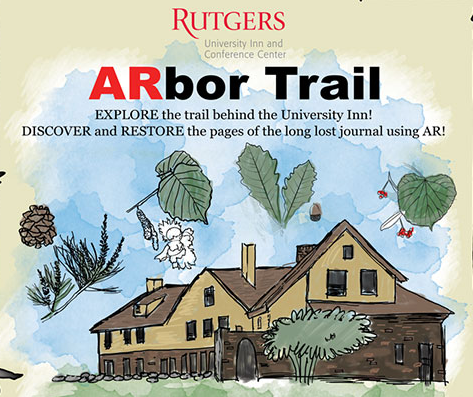An ideal mid-day outdoor walk, our Arbor Trail serves as an educational and passive recreational space for students, faculty and guests. It's easy to get outdoors at the Inn.

Trail Head
The trail begins to the right of the brick patio overlooking the great lawn. A wooden marker indicates the trail head. The stone staircase leads you past the upper pond. At the fork, you may choose to follow the loop in either direction. Selecting to go to the right first will lead you along the most recently restored portion of the trail. The path is soft-packed forest floor and gently slopes uphill. You will then encounter the historic apple orchard to your right. Upon reaching the meadow, you may again choose to walk right or left in a small loop. Making a right will lead to a trickling spring-fed creek. Continue around the meadow loop and make a right. On your right will be the lower pond. You may relax and enjoy the bird-song from the wooden bench. To complete the loop, walk to your left and up the hill. The trail meets up again just shy of the upper pond. Continue up the stone steps to the patio to complete the trail.
Several frogs have made homes in both ponds. Occasionally, if you are still enough, you can catch them sunning themselves. Grey squirrels, chipmunks, rabbits, red foxes, white-tailed deer, and groundhogs have also been spotted on the site. As you make your way along the trail you may notice a diversity of plantings as part of the dense foliage, including numerous original plantings. The following are a few of the key specimen that were planted, some still remain today on the site:
- Weeping European Beech (Fagus sylvatica pendula)
- Purple leaf European Beech (Fagus sylvatica atropunecea)
- English Yew (Taxus baccata)
- Mountain Laurel (Kalmia latifolia)
- Winged Euonymous or Burning Bush (Euonymous alatus)
- Black Locust (Robinia pseudoaccacia)
- Paper Birch (Betula papyifera)
- Kurume Hybrid Azalea (Rhododendron obstusum)
- Yodogawa Azalea (Rhododendron yedonense)
- Common Persimmon (Diospyros virginiana)
- Sugar Maple (Acer saccharum)
- Upright Japanese Yew (Taxus cuspidata capitata)
- Creeping Lilly-turf (Liriope spicata)
- Hinoki False Cypress (Chamacyparis obtusa)
- Lacebark Pine (Pinus bungeana)
- Common Hackberry (Celtis occidentalis)
- Flowering Dogwood (Cornus florida)
- Common Lilac (Syringa vulgaris)
- Ginkgo (Ginkgo biloba)
- Japanese maple (Acer palmatum)
- Blue Rug Juniper (Juniperous horizontalis wiltoni)
The Arbor Trail: A History
The Arbor Trail is a historic nature trail and tree collection built in 1911 as part of the Carpender Estate, founded by Sydney B. Carpender and his wife Louise Johnson. Originally built to reflect the rolling meadows of England, the estate served as a pastoral retreat for the Carpender family. A refrigeration engineer, Carpender used water from the ponds on the site to cool the family home during warmer months. The site was also used to test foreign tree species in the United States as part of the USDA testing program.
The Carpender Estate was acquired by Rutgers University in 1965 under the auspices that the site be maintained for education purposes; however, since 1975, the trail had been left untouched. This site has great historical value to Rutgers University and the city of New Brunswick. Its construction represents the pleasure garden era of landscape architecture, and, represents the union of two major influential New Brunswick families, the Carpenders and the Johnsons.
The site has great potential to act as a garden retreat, just as it had many years ago. It can provide a sort of forested escape that can be found nowhere else in New Brunswick. Furthermore, this site can serve as a living lab, allowing Rutgers students to witness hands-on, the concepts they learn in the classroom.
Today, the Arbor Trail serves as an educational and passive recreational space for students, faculty, staff, and guest of Rutgers University. Redevelopment of this site began in the spring of 2013 as a result of student involvement, and much of the site today is still undergoing restoration. This site not only provides an outdoor classroom space for learning environmental sciences, but it also pays homage to the history of New Brunswick's past.
Read more about the Arbor Trail's re-discovery and restoration here:
- The Arbor Trail, Part I
- Unearthing a Buried Treasure, Part II: Student’s Vision for Trail Renovation Enabled by Fellow Students
- University Students Rehabilitate 100-Year-Old Cook Campus Trail